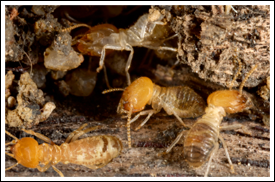Flying Insects
Fabric Pests
Rodents
Termites
 Termites cause more damage each year than fire, floods, and storms combined making termite control in NJ a top priority for any home or business owner. With over two decades of experience in termite removal in NJ, Pest-Gone, LLC provides top quality pest and termite control in NJ for termites, carpenter ants, and other wood destroying insects. At Pest-Gon, Inc., our Termite removal service provides a valid termite inspection and termite treatment in NJ with our gold seal warranty- giving you complete peace of mind.
Termites cause more damage each year than fire, floods, and storms combined making termite control in NJ a top priority for any home or business owner. With over two decades of experience in termite removal in NJ, Pest-Gone, LLC provides top quality pest and termite control in NJ for termites, carpenter ants, and other wood destroying insects. At Pest-Gon, Inc., our Termite removal service provides a valid termite inspection and termite treatment in NJ with our gold seal warranty- giving you complete peace of mind.
Leaving a termite infestation untreated can lead to significant damage to your home or commercial property in the matter of months. Let the termite removal experts at Pest-Gon, Inc. provide to you a comprehensive termite inspection and termite treatment for your NJ property with just one simple call.
When you call, our termite control consultants will provide you with information that you can understand! We will explain the termite inspection, termite removal process, and the eco-friendly methods used to protect your home or commercial property. So don't let termites destroy your most important investment, call Pest-Gone, LLC termite treatment services today!
WE OFFER FREE TERMITE ESTIMATES!
Call Pest-Gone, LLC NJ Pest Control to speak to a Termite Pest Control Professional today at 732-356-0024
“We Always Guarantee our Work”
Please read below to learn more about Termite Control and Termite Treatment in NJ:
Size
Worker: 1/8 inch in length
Soldiers: body is similar to that of the worker with an elongated head with pincer-like mandibles.
Supplementary Reproductive: about an inch in length with no wings or very short non-functional wings
Primary Reproductive: about an inch in length, with four wings of equal size.
Color
Worker: light colored.
Soldier: light colored with brown head.
Supplementary Reproductive: light colored.
Primary Reproductive: dark brown/black
Primary Reproductive is the termites most often seen in the open. They are commonly referred to as "swarmers".
Behavior
This termite is known to have major swarms occurring in May and June, but small flights can occur at any time of the year. Swarming is the primary way the termite naturally spreads after it has been transported to a new area. Three elements are needed for swarming to be effective: 1) Proper food resources (cellulose and wood), 2) moisture, and 3) a physical niche.
As the colony grows, specialized castes are produced for the different tasks required. The first caste produced is the workers. The second caste produced is the soldiers. The third caste to appear is the reproductive. Two types, primary and supplementary, are produced in a Formosan subterranean termite colony. The two types have different functions. Primary reproductive swarm and start new colonies. They are called alates or swarmers. Although thousands of primary reproductive are produced each year, they all leave the nest. Primaries cannot become reproductive if they remain in their colony of origin. In a Formosan colony, the only primaries that reproduce are the original king and queen that started the colony. Supplementary reproductive can become reproductive only in the colonies in which they were born. They take over reproduction when the primary king or queen dies or becomes separated from the main colony.
Habitat
Subterranean termites live in colonies in the ground, building vertical tunnels that look like mud tubes above ground level so that they can search for food. Because Subterranean termites will die if exposed to air for an extended period of time, the tunnels provide protection from the open air allowing workers to carry food to the nest. Subterranean termites can form tunnels through cracks in concrete, so slab homes are not exempt from these termites. They need to stay in contact with the soil in order to survive, unlike Dry wood termites that only need low moisture.
Tips for control
There are several things a homeowner can do which can help in preventing termite infestations or make them easier to detect:
-Store firewood away from the house. Carefully inspect used lumber, furniture and other wooden articles for termite infestations.
-Make sure at least four inches of the foundation can be seen all around the homes. Siding should not extend into the soil. Mulch and soil should not be high enough to cover the siding.
-Make sure water drains away from the foundation. Accumulation of water next to the foundation is important for the survival of a termite colony next to a home. Rain gutters are ideal; however, the downspout should direct the water away from the house.
-Roof or plumbing leaks can allow termites to survive above ground in a house. These should be corrected as soon as possible.
-Paint will protect exposed wood against termites for about five years, and commercial pressure treated wood will provide longer lasting protection. Before painting, all cracks and crevices should be filled with putty or plastic wood.
-Certain woods are naturally resistant to termite attacks. Among these woods are redwood core, bald-cypress, mahogany and Spanish cedar. These types of wood will become susceptible after several years of weathering.
